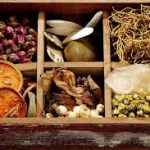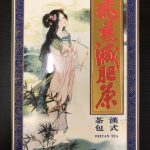GOU QI BERRY(200G)
€15.00
GOU QI BERRY
Goji berry bush is a real treasure. All its fruits, leaves, flowers, and root bark (Di Gu Pi) are superior herbal tonics. Goji berries, also known as Gou Qi Zi, have been regarded as general nutritive tonic, noted anti-aging herb, and eyesight-improving medicine since long time ago. In order to keep in good health, promote good eyesight, and slow down aging, people keen on nourishing life consume it on daily basis by making tea, soaking in rice wine, stewing soup, cooking congee, and many other ways. That is why this herb is frequently found in many excellent cuisine and herbal recipes. Thanks to it is rich in a variety of nutrients such as carotene, vitamin A1, B1, B2, C, calcium, iron and other necessary nutrients, today this miracle fruit has been extensively applied for many purposes. So, what is goji berry good for? How to eat and how to use it to make the most use of its health benefits? If you have not got a clue on these questions, seemingly you have to know more information about goji berries.
What is goji berry?
Medicinally it mainly refers to the dried ripe fruit of Lycium barbarum L., a plant belonging to the family Solanaceae. It is usually harvested in summer and autumn when the fruits turn red. After the harvest, dry by hot air before remove the stems, or dry in the air till it wrinkles first, and then dry in the sun. As a matter of fact, goji is the general name for Lycium fruit commodity and the plants of Lycium barbarum and Lycium chinense Mill. And sometimes it also means some other varieties, such as Lycium barbarum L. var. auranticarpum K. F. Ching var. nov., Lycium barbarum L. var. barbarum., Lycium chinense Mill. var. chinense, Lycium chinense Mill. var. potaninii (Pojark.) A. M. Lu, Lycium cylindricum Kuang, Lycium dasystemum Pojark., Lycium dasystemum Pojark. var. dasystemum, Lycium dasystemum Pojark. var. rubricaulium A. M. Lu var. nov., Lycium ruthenicum murr., Lycium truncatum Y. C. Wang, and Lycium yunnanense Kuang.
This herb has many common names, including Barberry Matrimony Vine, Gou Ji Zi, Chinese Boxthorn, Barbary Wolfberry Fruit, Chinese Wolfberry fruit, Lycii Berries, Fructus Lychii Chinensis, Fructus Lycii, Fructus Lycii Berry, Ning Xia Gou Qi, Goji Chinois, Tibetan Goji Berries, Gouqizi, Licium Barbarum, Lyciet, Himalayan Goji berry fruit, Lyciet Commun, Lyciet de Barbarie, Lyciet de Chine, Lycii Chinensis, Lycii Fruit, Fruit of Barbary Wolfberry, and so on.
Medicinally it is similar to spindle and oval, 6 to 20mm in length and 3 to 10mm in diameter. Surface is red or dark red, with a small convex style mark on the top and white stem mark on the base. Peel is pliable, tough, and slightly wrinkled. Flesh is fleshy, soft and moist. Seeds are similar to kidney, flat and warped, 20 to 50 in number, 1.5 to 1.9mm long, 1 to 1.7mm wide, and with pale yellow or brown skin. In addition, it has slight odor and sweet flavor.
Ripe Lycium barbarum contains betane, atropine, hyoscyamine, zeaxanthin, scopoletin, carotene, thiamine, riboflavin, niacin, and vitamin C. Seed contains amino acids, trace elements, 7.09% polysaccharide, taurine, ?-aminobutyric acid, and more. Amino acids include aspartic acid, proline, alanine, leucine, phenylalanine, serine, glycine, glutamic acid, cysteine, lysine, arginine, isoleucine, threonine, histidine, tyrosine, tryptophan, and methionine. Trace elements include potassium, calcium, sodium, zinc, iron, copper, chromium, strontium, lead, nickel, cadmium, cobalt, magnesium and others.
Goji berry benefits
This herb was initially recorded for medicinal purpose in The Book of Songs, with more than 3,000 years of history. Its name of Gou Qi Zi first appeared in Shen Nong??s Herbal Classic?? and there it was classified as one of the best herbs. And ever since this herb has been one of the herbalists?? favorites. In the East Jin Dynasty, Ge Hong, a medical master and alchemist, got juice by pounding it alone for the treatment of eye disorders. In Tang Dynasty, Sun Simiao, A famous Taoist and medical expert, combined this herb with others to make liver tonic teapills to cure blurring vision. And the famous Five Ancestors Teapills, formulated by Li Ting in Tang Dynasty, is composed of goji, Semen Cuscutae, and other herbs for male impotence, premature ejaculation, infertility, premature graying, and urine endless. Now this herb is enjoying the enormous popularity worldwide by made into goji berry tea, bars, beer, cookies, cuttings, drinks, dessert, extract, eye cream, powder, essential oil, face mask, facial cream, smoothie, jam, jelly, muffin, supplement, tablets, and more. In recent years, science has got a further understanding on goji berrys by analyzing its chemical composition and pharmacology.
Modern goji pharmacological actions
1. It improves immune function, enhances the body??s ability to adapt to a variety of noxious stimuli;
2. It significantly inhibits the generation and spread of cancer cells;
3. It improves eyesight;
4. It tremendously increases the reserves of muscle glycogen and liver glycogen. Thus it increases human energy and has anti-fatigue effect;
5. It improves brain function and enhances learning and memory capabilities;
6. It boosts the body??s adaptive defenses, which thus enhances the endurance to various noxious stimuli, such as hypoxia, cold, blood loss, and more;
7. It enhances the body??s hematopoietic function by promoting the proliferation of hematopoietic cell, increasing white blood cell count, and reinforcing the body??s hematopoietic function;
8. It effectively enhances various organs?? functions, improves brain function, resists free radicals as an antioxidant, and then delays aging;
9. It dramatically reduces the levels of serum cholesterol and triglyceride, reduces and prevents arteriosclerosis and hypertension;
10. It relieves allergy symptoms, e.g. gastrointestinal tract bleeding and joint pain. And this effect is achieved by regulating the endocrine;
11. It protects liver and nourishes kidney by inhibiting the deposition of fat in the liver cells and promoting the regeneration of liver cells;
12. The guanidine derivatives contained can lower blood sugar. So it can be used as health product for people with diabetes;
13. Its tea helps with weight loss and obesity;
14. It treats chronic hepatitis and cirrhosis.
Proven goji herbal remedies
Traditional Chinese medicine (TCM) tends to believe that it is sweet in taste and neutral in properties. It goes to channels of liver, kidney, and lung. Common functions are nourishing the liver and kidney and moistening lung. Key goji berry uses and indication are the deficiency of liver and kidney, light-headedness, blurred vision, soreness and weakness of waist and knees, ED (erectile dysfunction) and damage of essence, consumptive cough, extreme thirst, and so on. Recommended dosage is 5 to 15 grams in decoction, tea pills, powder, paste, and liquor agents. Regularly the preferable goji berry daily amount is 20 grams for healthy adults and 30 grams for treating patients.
1. Qi Ju Di Huang Wan. Qi Ju Di Huang Wan comes from Yi Ji Bao Jian (Precious Mirror for the Advancement of Medicine). It is commonly formulated for liver-kidney deficiencies induced giddiness and dry eyes and sore eyes. Other major herbal ingredients include Shu Di Huang (Rehmannia), Shan Zhu Yu (Fructus Corni), Fu Ling (Poria), Ju Hua (Chrysanthemum Flower), and so on.
2. Gou Qi Wan. This formula comes from Gu Jin Lu Yan Fang (Recorded Prescriptions in Ancient and Modern Times). It is exclusively designed for internal lesion caused by overexertion and asthenic disease. Other two herbs are Gan Di Huang (Dried Rehmannia) and Tian Men Dong (Asparagus Tuber).
3. Si Shen Wan. Si Shen Wan is from Rui Zhu Tang Jing Yan Fang (Formulas from Experience from the Rui Zhu Tang Pharmacy). This prescription is mainly used for kidney deficiency induced blurred vision or slight corneal opacity. Other primary herbs are Hua Jiao (Sichuan Peppercorns), Xiao Hui Xiang (Fennel Seed), Chuan Lian Zi (Sichuan Pagoda Tree Fruit), and so on.
4. Gou Qi Zi Jiu. This prescription is from Yan Nian Fang (Prescriptions for Prolonging Life). It is goji berry-infused wine, mainly used for tonifying deficiency, growing muscles, retaining youthful looks, invigorating healthy people.
5. Gou Qi Zi San. This recipe comes from Tai ping sheng hui fang (Taiping Holy Prescriptions for Universal Relief). It is basically used for consumptive disease, deficient injury in lower energizer, slightly thirsty, and frequent micturition. The rest chief herbs are Huang Qi (Astragalus), Ren Shen (Ginseng), Gui Xin (Cinnamomi Cortex), Dang Gui (Dong Quai), Bai Shao (White Peony Root), and so on.
Popular goji berries recipes
1. Goji tea. It can be taken all year round, especially making tea on summer afternoons. It has a few health benefits ?? improve physical fitness and conducive to sleep. It works with Chrysanthemum morifolium, honeysuckle and rock sugar. But please keep in mind that never uses it with green tea.
2. Goji porridge. This is the best choice in winter. And it can mix with a variety of congee.
3. Goji stewing lamb. This is another excellent option for winter months.
4. Goji Frying mushrooms. Mixing this herb with common homemade cooking would be a good idea. This is a highly recommended one, especially for a vegetarian.
5. Goji corn soup. It is delicious and tasty. In addition, it looks good too.
Goji berry side effects and contraindications
As you can see now, goji berry is very rich in nutrients, which can be of great help on prevention and treatment of some diseases. Unfortunately, not all people are suitable to take this herb due to its warm nature. It is reported that overdose might lead to a few adverse reactions like skin sensibility, epistaxis, fever, and more. TCM wise, it shouldn??t be used in cases of excess heat caused by exogenous pathogenic factors and spleen deficiency accompanied with dampness and diarrhea.




